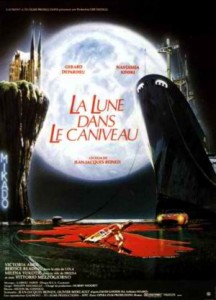“I should have told you — it’s you I want.”
|

Synopsis:
When his sister is raped and murdered, a stevedore (Gerard Depardieu) vows to find her killer; meanwhile, he falls for a wealthy young woman (Nastassja Kinski) and dumps his girlfriend (Victoria Abril).
|
|
Genres, Themes, Actors, and Directors:
- French Films
- Gerard Depardieu Films
- Nastassja Kinski Films
- Revenge
- Waterfront
Response to Peary’s Review:
As Peary notes, this follow-up to Jean-Jacques Beineix’s cult film Diva (1981) is “delirious, pretentious, and obscure”, but nonetheless contains “many powerful scenes” and some undeniably “erotic visuals”. Beineix purportedly based Depardieu’s character on photos of Marlon Brando in A Streetcar Named Desire (1951) — a noble intention, but one which ultimately doesn’t pan out; while Depardieu has his own kind of sexy animal magnetism, he never comes close to channeling the unique spirit of Brando’s Kowalski.
Redeeming Qualities:
- Nastassja Kinski as Loretta

- Depardieu — on a bet — breaking a solid block of ice in half by gnawing his way through it

Must See?
No. While the film was subject to much critical debate when it came out, it no longer warrants such attention.
Links:
|
2 thoughts on “Moon in the Gutter (1983)”
Basically, you pretty much probably want to stay far away from this one.
Trust me. Think of the wonderful things you can do with 138 minutes.
I would not say ‘MITG’ contains “many powerful scenes” – or any, really.
I would love to know what visuals in this film Peary considers “erotic”. Huh?!
I recall when ‘Diva’ made the film world fall in love with Beineix. He was allowed to slide (a bit) on that adulation. So he continued making his…unique…’art films’. ‘MITG’ is largely, maddeningly languorous in the way it’s filmed and pumped-up by its sense of self-importance. I wouldn’t call it the train wreck others have seen it as. It’s just DULL – and way too long for the story it’s telling. It’s not bad in a way that’s fun – although (if you do see it) you may find yourself fascinated anyway by just how misguided it is.
The main plot is clear and simple – but the various relationships on display teeter on the edge of incoherence. By the time you’re 20 minutes in, don’t be surprised if you find yourself not giving a hoot about anything you’re witnessing. The acting isn’t bad; it’s not all that good either – but, honestly, there’s just nothing for the poor actors to do convincingly.
There is more than a fair bit of wretched dialogue – some of it could touch your funny bone.
To be fair, the last few minutes do hint at some subtextual element that could be an intriguing possibility. Or maybe I was just *that* desperate for it at that point.
‘The Moon in the Gutter’ is a film that seems to split opinion and produce either adulation or loathing. I’ve seen it twice – once when it first came out (I was 18) and once more recently after I’d read the book (in a not particularly good print unfortunately).
It received a very hostile reception at the time, not least in France. A reaction had set in to Beineix’s first film which some felt they’d overpraised (rightly), TMITG was hugely expensive at a time of recession and Beineix didn’t exactly flatter his critics or seen unimpressed by his own cleverness. Beineix would be lumped together with Luc Besson and Leo Carax as part of the “cinema du look”. That term wasn’t exactly complimentary. It also wasn’t particularly accurate but the desire of critics to construct movements where they don’t really exist can’t be overstated (and it helps distribute films – try finding most of the work of French directors not labelled part of ‘The New Wave’. Good luck!). I can’t stand Besson whose work deserves the negative connotations of ‘cinema du look’ IMO (all surface, nothing underneath). Beineix (and Carax) are something else I think, although both were flames that burned for a sadly short period of time.
The key to the film is perhaps the difference in the American and European sensibilities (or, if that’s too “continental-ist’ – between commercial and art cinema). Beineix may be filming an American pulp novel but he isn’t making a conventional Hollywood narrative film. It was perhaps Beineix’s misfortune to be starting in direction a decade too late when plot-driven cinema was reasserting itself and the kind of 70s’ experimentations with the possibilities of cinema were being squeezed out. In narrative terms, TMITG does render a reasonably coherent narrative but its pacing is not within the expectations of classical 90 minute films. This a film of moods and atmospheres, of looks and colours.
Beineix’s film is more a riff on the Goodis novel, or a dream. It has a particularly dreamlike quality in its heightened visuals and its unfolding narrative structure that has a certain randomness, blind alleys, repetitions and elusiveness. It’s a dream of a port that is sort of Marseilles but isn’t, it’s a dream of a steelworks in perhaps the film’s most incredible shot, it’s a dream of a love and it becomes clear that cineaste Beineix is with ‘Vertigo’ in that given a choice between reality and a dream woman, men will choose the dream every time.
Some parts of the dream are more successful than others. I agree that Depardieu’s character struggles to make an impression. However Beineix’s real interest is with the women. Depardieu rejects his earthy real girlfriend Bella (Victoria Abril), the fool! The scene where Abril is on the swing in the garden must be one of the sexiest in all cinema. But Depardieu prefers to move into the orbit of mystery woman Loretta (Nastassja Kinski), the rich girl who seems possessive of some secret that will resolve the plot. In the film’s key moment, Kinski swoons in her red sports’ car with her hair over the seat and ‘Try Another World’ on the billboard behind her. But the promises that Kinski offers, and the modes that communicate them, are lies, the moon is in the gutter.
Observations that the characters are not ’rounded’ or ‘engaging’ are both true and miss the point entirely – they are archetypes and could not be more clearly encoded as such.
If pretension (as opposed to stupidity or lack of ambition) is your greatest crime in cinema, give this a miss. If your only way of looking at film is to ask “what happens next?”, give this film a miss, it’s not for you. Whether it’s a “must-see” movie I’d doubt, as both Beineix’s career and his approach didn’t go anywhere – they seem dead ends. If however you like vainglorious ambition, and are prepared to be delighted, amazed, bored and infuriated (not necessarily in that order), give this film a try. It’s perhaps one for the “recommended” section with a CM tag. If all films were like TMITG, cinema would soon die – but cinema has become a small world if there is not a place for films like it in its universe.